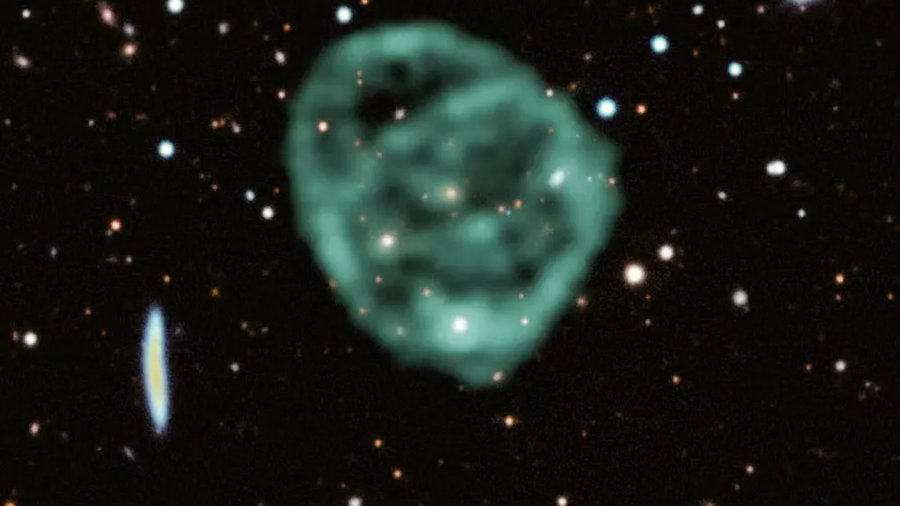Science
The Salt-Sized Robot That Thinks and Acts
27 December 2025

Phenomena have appeared on the distant frontiers of space, astounding even the most experienced astronomers. We are talking about ORCs—Odd Radio Circles—whose origin remains a mystery. Are they the result of cosmic explosions, galaxy collisions, or perhaps traces of previously unknown processes?
It’s rare for astronomy to encounter something completely new. Therefore, in 2019, when the ASKAP telescope in Australia captured strange mysterious structures in space, the scientific world erupted. Researchers named these objects ORCs (Odd Radio Circles). It was immediately clear that they were no ordinary phenomena. Their enormous size and unknown origin remain a mystery for astronomers today.
The circular shape resembles a classic soap bubble. This is common in space because a circle usually means we are looking at a spherical structure whose edges appear brighter since our line of sight passes through more of the glowing material. However, it soon became clear that these mysterious structures in space hide more than just ordinary gas bubbles.
You might like to read: Is It a Comet or an Alien Spacecraft? Harvard Scientist Suggests Extraterrestrial Technology
During their research, scientists found several such structures. Some were brighter, others barely visible. Interestingly, two of them, named ORC 2 and ORC 3, were located very close to each other, almost touching. The problem is, despite their proximity, they differed significantly. ORC 2 appeared as a bright ring, while ORC 3 resembled a faint, uniformly illuminated disk. Astronomers began asking themselves questions: why are such different objects next to each other? Are they related?
“If they are related, why are they so different?” scientists wondered in an article for Scientific American.
As more ORCs were discovered, more hypotheses about them emerged. Supermassive black holes quickly became a prime suspect. As astrophysicist Christopher Riseley from the University of Bologna explains in a 2024 paper published in the Astrophysical Journal, powerful jets of matter ejected from the vicinity of a black hole can “inflate” the surrounding gas, creating vast, strange mysterious structures in space that resemble the observed ORCs.
In short: matter falling onto a black hole swirls in a massive disk, and the magnetic fields inside it act as a cosmic catapult, launching streams of particles at speeds close to the speed of light. If such a jet hits a cloud of gas between galaxies, it can scatter the gas and form a gigantic, spherical structure.

However, astronomers quickly noticed that not all ORCs fit the same pattern. An example? An ORC named Cloverleaf captured researchers’ attention with its unusual X-ray emission. Analysis showed that this light comes from hot gas typical of colliding galaxy clusters. If this interpretation is correct, then Cloverleaf is located about 600 million light-years from us. Furthermore, its non-uniform structure indicates that it was formed as a result of a collision between two galaxy groups, which ejected huge amounts of energy into space.
Another fascinating ORC was discovered near the Large Magellanic Cloud (LMC), a satellite galaxy of the Milky Way. This object appears to be much smaller, with a diameter of about 150 light-years. This suggests we are dealing not with a gigantic cosmic event, but rather with a local explosion, the remnant of a supernova.
Interestingly, this ORC is located outside the main area of the LMC, where stars are relatively scarce. But as astronomers explain, stars are sometimes “ejected” from galaxies as a result of interactions with black holes or the explosions of their companions in binary systems. In such places, mysterious structures in space can form in a completely unexpected way.
Read also: An Awakened Black Hole Devoured a Star. What Was Hiding in the Cosmic Dust?
Everything points to the term ORC not signifying a single type of object. It is rather a collection of different phenomena that share one common feature. The mysterious structures in space we write about often look similar but can be formed as a result of completely different processes.
Today, ORCs remain a mystery. Although astronomers have been studying them for several years, the number of discovered objects is still small, and there are many theories about them. The Square Kilometre Array radio telescope network, which will begin operating in the coming years, may help solve the puzzle. The more ORCs we find and analyze, the closer we will be to understanding what these mysterious structures in space truly are. One thing is certain: space still has a way of surprising us in the most unexpected ways.
Read the original article: Na nocnym niebie pojawiły się zagadkowe kręgi. Nauka nie wie co je tworzy

Culture
26 December 2025


Zmień tryb na ciemny